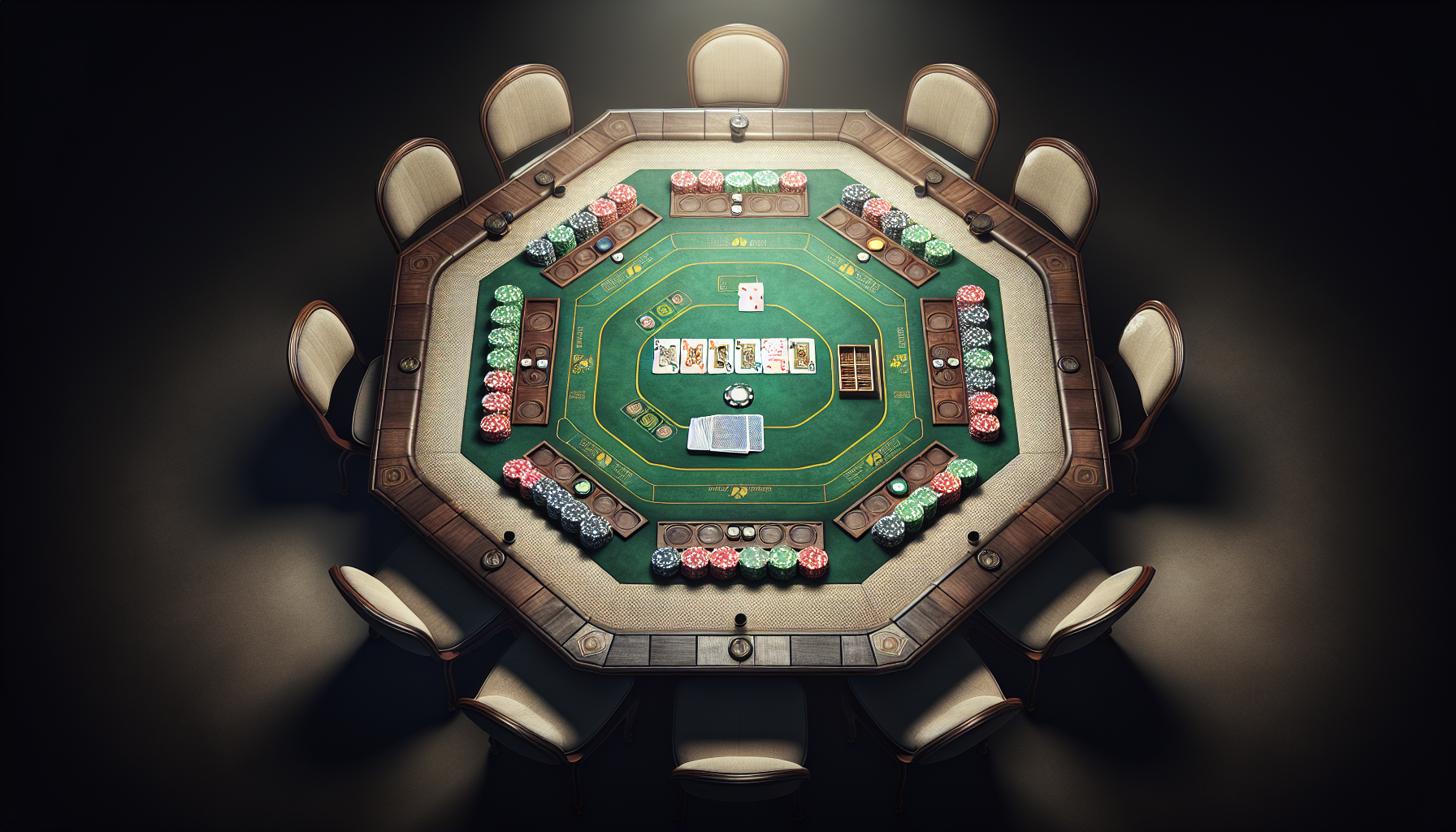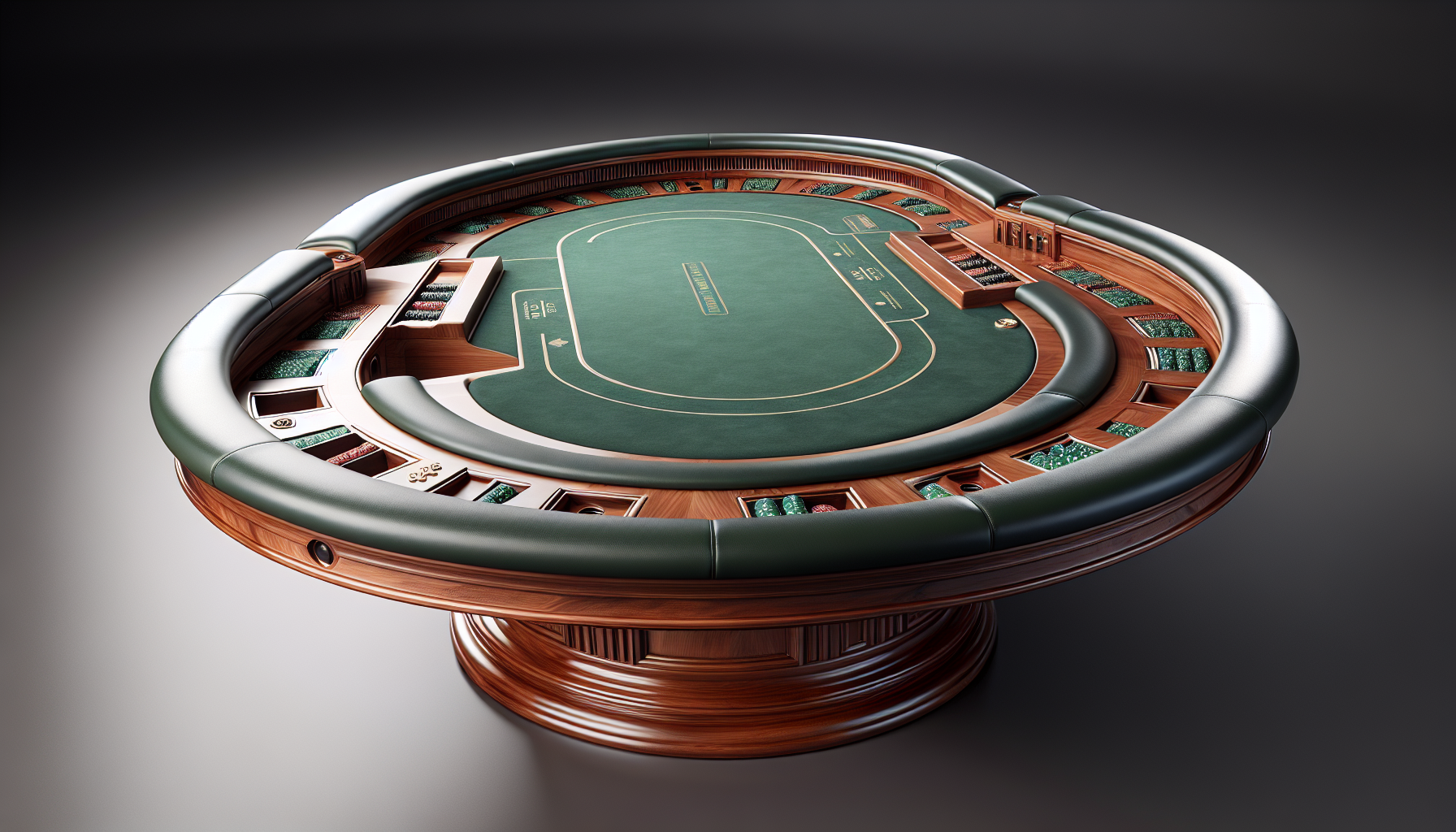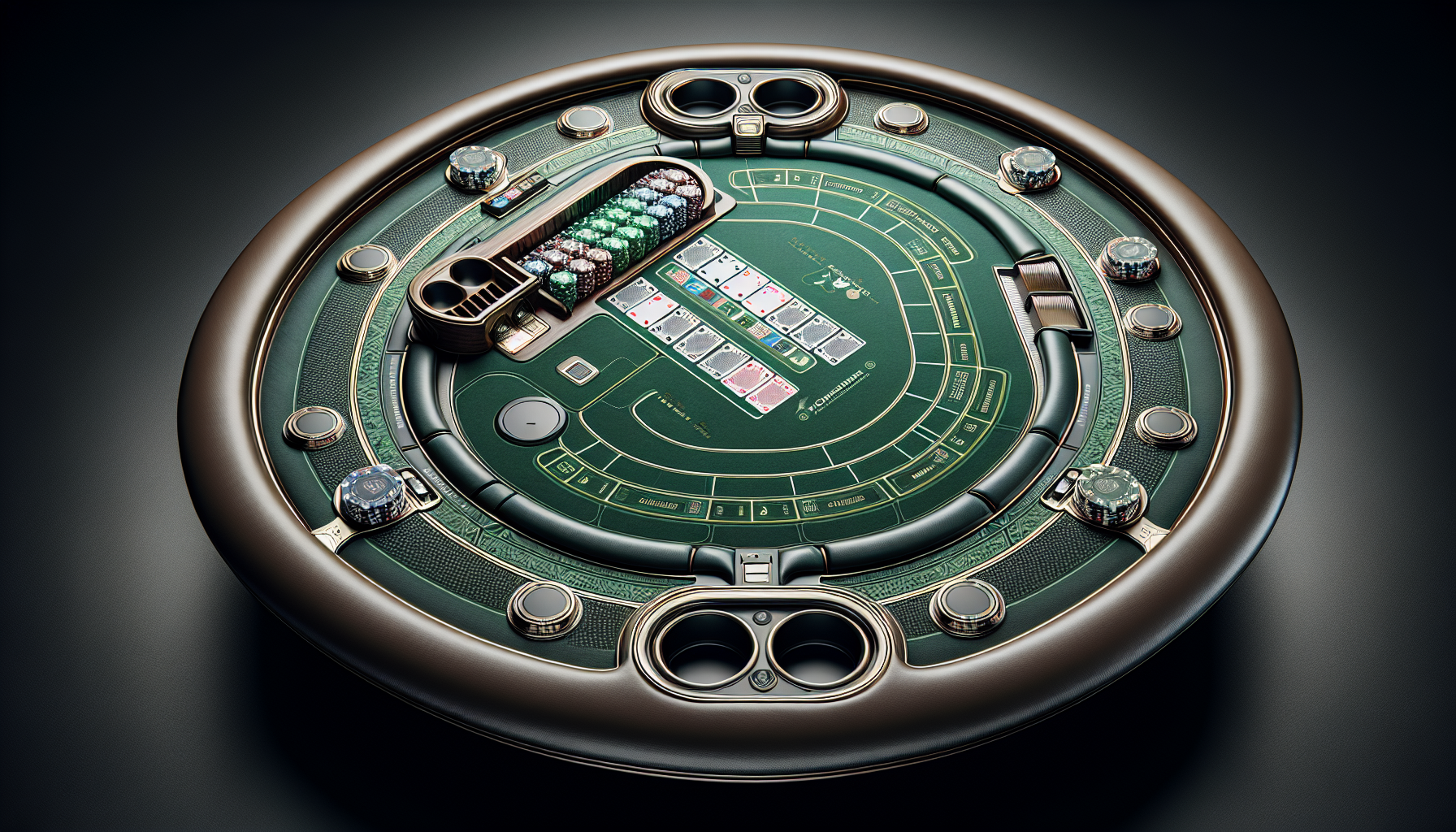Poker Table Shapes
When it comes to choosing the ideal poker table, the shape is an essential consideration. Different table shapes offer various benefits and suit different game settings. In this section, we will explore oval tables, round tables, and octagonal tables, each with its own unique characteristics.
Oval vs. Round Tables
Oval poker tables are the classic choice often found in casino poker rooms. They offer ample space for players to comfortably gather around and participate in the game. Oval tables can accommodate a larger number of players, making them suitable for larger poker games. These tables typically seat up to 8 people and provide a robust structure that can withstand frequent use. Additionally, many oval tables feature a folding design, allowing for easy transportation and storage.
On the other hand, round poker tables are versatile and take up less space. They are an excellent option for home games where players take turns dealing. Round tables typically come in permanent options, making them a long-lasting addition to a dedicated game room. While they may seat fewer players compared to oval tables, round tables provide an intimate and engaging gaming experience.
Octagonal Tables for Home Games
Octagonal poker tables have gained popularity for home games involving 4-6 players. These tables combine the best of both oval and round tables. Octagonal tables provide ample space for players while offering a more compact design compared to oval tables. The eight-sided shape allows players to have their own designated space around the table, creating an immersive gaming environment.
When choosing between different poker table shapes, consider the number of players you expect to accommodate and the available space. Oval tables are ideal for larger games, while round and octagonal tables are more suitable for smaller gatherings. To explore a range of poker tables, including options for sale, visit our article on poker tables.
Understanding the advantages and characteristics of different poker table shapes will help you select the one that best suits your needs and enhances your poker playing experience.
Poker Table Materials
When selecting a poker table, the materials used play a crucial role in the overall performance, durability, and aesthetics of the table. Two key aspects to consider are the table surface material and the construction of the table frame.
Velveteen vs. Suited Speed Cloth
The choice of material for the table surface is important as it directly affects the playing experience. Velveteen and suited speed cloth are two commonly used materials for poker table surfaces.
Velveteen is a soft and plush material that provides a luxurious feel to the table. It offers a comfortable playing surface, allowing players to rest their arms and hands without discomfort. However, velveteen lacks the smooth card slide characteristics of other materials. It is also prone to staining and may require more maintenance to keep it clean and in good condition.
On the other hand, suited speed cloth is made of polyester and stands out for its smooth card slide and water-resistant nature. This material offers enhanced performance and easier maintenance compared to velveteen. Suited speed cloth allows cards to glide smoothly, making for a more enjoyable and professional playing experience. It is also more resistant to spills and stains, making it easier to clean and maintain the table. For those seeking a durable and low-maintenance surface, suited speed cloth is often the preferred choice.
Construction of Poker Table Frames
The construction of the poker table frame is another important consideration. The frame provides stability and support to the table, ensuring that it can withstand the rigors of regular use.
Poker table frames are typically made of metal or hardwood for the legs, while the base is often constructed using fiberboard or plywood. The legs need to be sturdy and well-designed to prevent wobbling or instability during gameplay. High-quality poker tables also incorporate high-grade foam padding underneath the table surface for player comfort.
Additionally, the betting line on a poker table serves as a boundary between chips in play and those that are not. It helps to define the area where bets can be placed and keeps the game organized.
When choosing a poker table, it’s important to consider the quality of the frame construction to ensure durability and longevity. A solidly constructed frame will contribute to the overall stability and performance of the table.
By understanding the differences between materials like velveteen and suited speed cloth, as well as considering the construction of the table frame, you can make an informed decision when selecting the ideal poker table for your gaming needs. Whether you opt for a ready-made table or decide to build your own, the choice of materials will greatly impact your poker playing experience.
Seating Arrangements
When it comes to poker tables, seating arrangements play a crucial role in ensuring a comfortable and enjoyable gaming experience. In this section, we will discuss the standard poker table sizes and the number of players that can be accommodated.
Standard Poker Table Sizes
Standard poker tables come in various sizes, depending on whether they are permanent or foldable models. The dimensions of these tables are typically measured in inches and refer to the length, width, and height. Here are some common measurements:
- Standard permanent home poker tables: 92x44x30 inches (Triangle Billiards).
- Foldable poker tables: 84x42x30 inches (Triangle Billiards).
- Smaller foldable models: Approximately 73 inches long and 32 inches wide (Triangle Billiards).
- Tabletop versions: Typically 48 to 60 inches wide (Triangle Billiards).
It’s important to consider the available space in your home or playing area when choosing a poker table size. Additionally, foldable models are ideal for those who require flexibility and easy storage.
Number of Players per Table
The number of players that can be comfortably seated at a poker table depends on its shape and size. Here are some general guidelines:
- Oval poker tables: These tables can seat up to 8 people (Triangle Billiards). They provide ample space for players and often have a robust structure. Oval tables are also designed to fold up for easy transport, making them a popular choice for home games.
- Round poker tables: Round tables are less common and are typically only available in permanent options. They are often found in casinos and poker rooms, accommodating 8 to 10 players.
- Octagonal poker tables: Octagonal tables have become popular for home games involving 4 to 6 people. The shape allows for comfortable seating and easy interaction among players.
Determining the appropriate number of players for your poker table is essential to ensure everyone has enough space to play comfortably. Consider the size of your regular poker group and select a table that accommodates the desired number of players.
By considering the standard poker table sizes and the number of players you want to accommodate, you can choose a poker table that suits your needs. Remember to also explore other factors such as the materials used, additional design features, and price ranges to find the ideal poker table for your gaming experience. If you’re interested in building your own poker table, stay tuned for our section on DIY Poker Tables.
Poker Table Design Features
When it comes to poker tables, there are various design features that can enhance your gaming experience. These features are designed to provide both functional and aesthetic value, creating a professional-style atmosphere for your poker games.
Built-in Chip Trays and Cupholders
Built-in chip trays and cupholders are common design features found in many poker tables. Chip trays provide a convenient place to store and organize your poker chips, keeping them easily accessible during gameplay. This eliminates the need for separate chip storage containers, ensuring a clutter-free and organized table.
Cupholders, on the other hand, allow players to keep their beverages within reach without worrying about spills. This feature is particularly useful during long gaming sessions, as it eliminates the risk of damaging the playing surface or cards. Additionally, cupholders help maintain a clean and tidy table, preventing any accidental spills that could disrupt the game.
Dealer Stations and LED Lights
Some poker tables come equipped with dealer stations, which provide a designated space for the dealer to sit and manage the game. These stations often include chip storage compartments, card shufflers, and other amenities that facilitate smooth gameplay. Having a dedicated area for the dealer helps maintain order and efficiency during the game.
Another popular design feature is LED lights. These lights are strategically placed around the table, illuminating the playing surface and enhancing the overall ambiance. LED lights not only create a visually appealing atmosphere but also improve visibility, making it easier for players to see their cards and make informed decisions.
The inclusion of built-in chip trays, cupholders, dealer stations, and LED lights in a poker table can elevate your gaming experience and provide a professional touch. These design features not only add functionality but also contribute to the overall aesthetics of the table.
When choosing a poker table, consider the specific design features that best suit your preferences and gaming needs. Whether you prioritize convenience, organization, or a sophisticated atmosphere, there are tables available to cater to your requirements. Explore different options and find a poker table that combines both style and functionality to enhance your poker playing sessions.
Choosing the Right Poker Table
When it comes to selecting the ideal poker table, there are several factors to consider. From the size and shape of the table to the materials used and additional features, each element plays a role in enhancing your poker experience. Let’s explore the key factors to consider when choosing the right poker table.
Factors to Consider
-
Size and Space: Assess the available space in your game room or designated poker area. Consider the dimensions of the table and ensure it fits comfortably in the room without overcrowding. Keep in mind that players need sufficient space to sit and move around the table.
-
Materials and Construction: The quality and durability of the table are important considerations. Look for tables made from sturdy materials, such as solid wood or high-quality composite materials. The construction should be solid and reliable to withstand regular use.
-
Playing Surface Upholstery: The playing surface of the table is typically covered with felt or a similar fabric to ensure cards do not get marked and provide a smooth playing experience. Opt for a table with a durable and comfortable playing surface, such as poker table felt, which can be easily replaced if needed.
-
Price and Budget: Set a budget for your poker table purchase. Prices can range from $500 to above $5,000 depending on the quality and features of the table. Basic foldable tables are suitable for beginners, mid-range tables offer entry-level professional quality, and high-end tables provide an elegant design and solid construction for serious poker enthusiasts looking for a long-term investment in quality (Just Poker Tables).
Price Ranges and Quality Levels
| Price Range | Quality Level |
|---|---|
| $500 – $1,000 | Beginner/Entry-Level |
| $1,000 – $3,000 | Mid-Range/Professional Quality |
| $3,000 – $5,000+ | High-End/Premium Quality |
Table prices should be considered alongside the quality and durability of the table. While poker mats may be cheaper, investing in a poker table is a better long-term option due to their durability, minimal maintenance costs, and ability to withstand scratches and spills (Just Poker Tables).
By considering these factors and price ranges, you can make an informed decision when choosing the right poker table for your needs. Whether you opt for a poker table for sale, poker table top, folding poker table, or even a custom poker table, carefully evaluating these factors will help you elevate your poker experience.
DIY Poker Tables
For poker enthusiasts who enjoy a do-it-yourself project, building your own poker table can be a rewarding endeavor. By constructing your own poker table, you can customize it to your specifications and create a unique gaming experience. Here, we will discuss the materials and blueprint required for building your own poker table.
Materials and Blueprint
To build a sturdy and durable poker table, it is recommended to use 3/4″ plywood for the top surface. This thickness provides stability and allows for easy replacement of the felt multiple times, ensuring your poker table lasts for years to come. Additionally, you will need materials such as MDF (Medium-Density Fiberboard) or select pine boards for the table frame, black strap hinges, and table leg braces (Quora).
When it comes to the blueprint, there are various plans available for purchase from woodworkers on platforms like Etsy. These blueprints provide detailed instructions and measurements for building a poker table from scratch. They often include step-by-step guidance on cutting and assembling the materials, ensuring a smooth construction process.
Building Your Own Poker Table
Once you have gathered the necessary materials and acquired a suitable blueprint, it’s time to begin building your own poker table. Here is a general overview of the construction process:
- Gather all the required materials and tools, including plywood, MDF or pine boards, strap hinges, table leg braces, screws, and a staple gun.
- Follow the instructions provided in the blueprint to cut the plywood to the appropriate dimensions for the poker table top. This typically involves cutting an oval or octagonal shape, depending on your preference.
- Construct the table frame using the MDF or pine boards, following the measurements and guidelines provided in the blueprint. Attach the strap hinges and table leg braces to ensure stability.
- Attach the plywood top to the table frame using screws, ensuring a secure and even connection.
- Once the basic structure is complete, it’s time to add the finishing touches. Cover the poker table top with a high-quality poker table felt, ensuring a smooth and professional playing surface. Secure the felt using a staple gun, making sure it is tight and wrinkle-free.
- Consider adding additional features such as built-in chip trays, cupholders, and dealer stations to enhance the functionality and aesthetics of your poker table. LED lights can also be a stylish addition, creating a captivating ambiance during your poker games (Just Poker Tables).
Building your own poker table can be a fun and rewarding project, allowing you to create a personalized gaming experience. By following a well-designed blueprint and using high-quality materials, you can construct a durable and stylish poker table that will impress your friends and elevate your poker nights.








